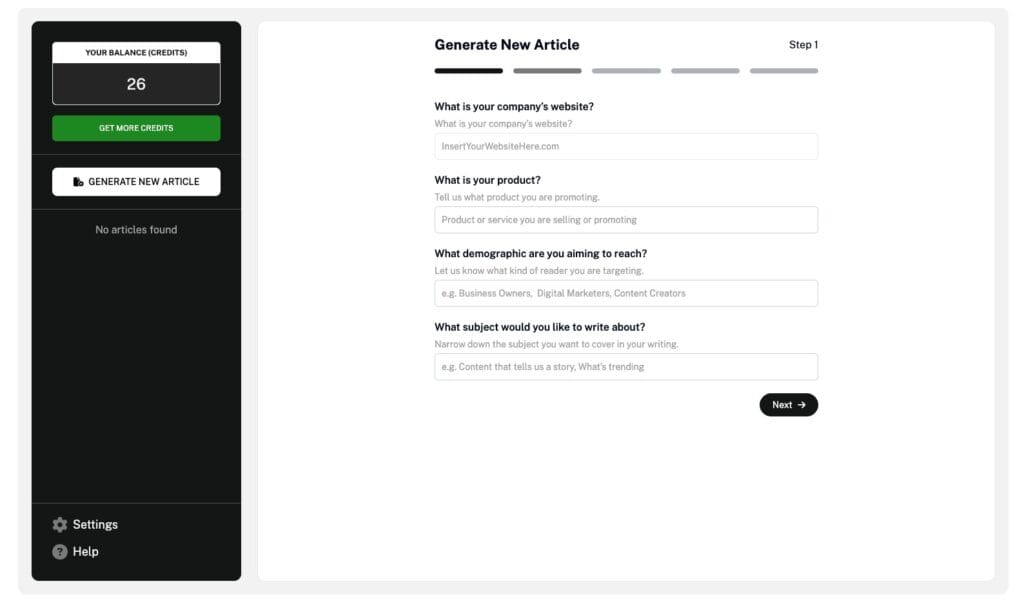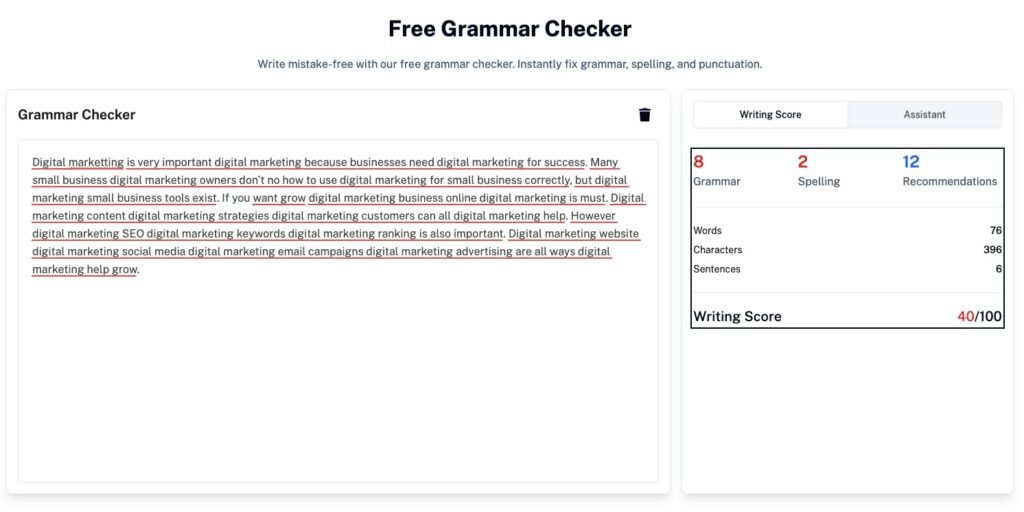When trying to rank higher on search results pages, you might be used to putting as many keywords as you can in an article.
But eventually, you notice it stops working, and your tried-and-true approach isn’t delivering results.
Times have changed. This strategy, known as keyword stuffing, is an outdated SEO tactic that has come and gone.
Search engines like Google now rank sites based on updated ranking guidelines.
And beyond that, reading something that’s simply stuffed with keywords is off-putting, and certainly doesn’t do much for the reader experience.
In this guide, we’ll show you how to avoid keyword stuffing and cover new writing techniques that should please both readers and algorithms.
Key Takeaways
- Keyword stuffing is the excessive use of the same terms in your content, which can hurt readability, frustrate readers, and lower your search rankings.
- To avoid keyword stuffing, focus on quality content with natural writing and content flow, incorporate long-tail keywords and related terms, and place keywords thoughtfully in headers and text to create content that satisfies both readers and search engines.
- Auditing your content for over-optimization, including checking keyword density, evaluating anchor text, and comparing with competitor pages, helps maintain SEO effectiveness and ensures your content remains reader-friendly.
What Is Keyword Stuffing?

Keyword stuffing is the outdated practice of overloading as many keywords as you can into your content in an attempt to manipulate search engine rankings.
Years ago, this was actually a common tactic, as older search engines relied more on keyword frequency to measure relevance.
But today, algorithms are smarter. Searches can analyze context and user intent and check for overall quality. Keyword stuffing is penalized, and Google now includes it in its spam policies.


Never Worry About AI Detecting Your Texts Again. Undetectable AI Can Help You:
- Make your AI assisted writing appear human-like.
- Bypass all major AI detection tools with just one click.
- Use AI safely and confidently in school and work.
The same goes for Bing’s Webmaster guidelines.
Examples of Over-Optimized Content
Overoptimized content refers to using SEO tactics too aggressively, including keyword stuffing.
It often appears in more than just the main text: meta descriptions, subheadings, and even image tags.
Below are some common examples where you might have over-optimized content:
- Over-optimizing the main content:
“Our handmade candles are the best handmade candles you’ll find. Each handmade candle is crafted by experts in handmade candles, making our handmade candles perfect for anyone who loves handmade candles.”
- Over-optimizing URLs (web addresses):
www.example.com/handmade-candles-best-handmade-candles-online
- Over-optimizing the anchor text (for placing hyperlinks):
Check out our handmade candles online USA handmade candles collection.
- Over-optimizing the title tags and meta descriptions:
Title Tag: Handmade Candles | Best Handmade Candles | Handmade Candles for Sale
Meta Description: Shop handmade candles. Our handmade candles are the best handmade candles. Buy handmade candles online now.
- Over-optimizing the alt text (image descriptions):
<img src=”giftset.jpg” alt=”handmade candle set handmade candle handmade candle gift” />
Overoptimized content doesn’t just look awkward. It pulls the focus away from the reader and puts too much emphasis on chasing rankings.

Why Keyword Stuffing Hurts SEO
Search engines now measure what’s called topical authority, which reflects how well your content explains a subject and meets user intent.
That means that overloading pages with keywords won’t matter anymore and can even actively hurt your SEO.
Here are reasons why you should stop using too many keywords:
- Hurts readability: Repetitive keywords break the natural flow of your content, making it harder to read and driving visitors away.
- Search engine penalties: Most search algorithms now punish the overuse of keywords ,awhichwill lower your rankings.
- Poor user experience: Most readers come for answers. If your content reads awkwardly or feels forced, it’ll push them away instead of keeping them engaged.
- No long-term value: Keyword trends come and go, and sustainable rankings depend more on the quality of the content itself.
The message is clear—modern SEO values natural, helpful, and contextually relevant writing.
You’re encouraged to become a better writer by focusing on clarity and delivering value that goes beyond keywords.
Strategies to Avoid Keyword Stuffing
To stay competitive in the rankings, the goal is to write content with purpose. And as easy as this may seem, you could still be adding too many keywords to your content without even noticing.
Stay ahead by using these strategies to avoid keyword stuffing.
Focus on Search Intent
Search intent is the reason behind a user’s online search. Your content should answer what they’re hoping to find, learn, or do with their query.
For instance, if there’s a common search to find the “best running shoes for flat feet,” they’re looking for recommendations and comparisons of why one brand may be better than the other.
Build content that answers that search query directly.
A quick trick is to summarize what your audience expects to find before creating your draft, so there’s clear direction from the start.
Use Synonyms and Related Terms
Search engines use semantic search (analyzing context) to understand topics.
This means that they understand related terms and variations of a specific keyword or topic.
So if your main keyword is “digital marketing,” you can incorporate variations like “online advertising,” “social media campaigns,” “content marketing,” and “paid search.”
These related terms add depth to your content while still supporting your SEO.
Search engines are smart enough to recognize these and will view you as an authority on the topic.
Write for Flow, then Edit for Keywords
When writing, focus first on what will make valuable content. What “great” looks like depends on your goal.
For a product page, it’s about highlighting key benefits upfront and answering common objections like price or compatibility.
If you’re writing a guide, you’ll need to break down complex topics into easy-to-follow steps.
Once you’ve drafted your content, review it and then add the keywords only where they feel natural. If a keyword sounds forced, remove or rephrase it.
Monitor Keyword Density
Repeating keywords will make your content sound clunky.
A good way to find the sweet spot is to measure keyword density, which tells you how often a term appears in your content compared to the total word count.
There’s no strict formula, but most effective content has primary keywords at around a density of 2-3% of total words.
This means to use your primary keyword 2-3 times per 100 words to prevent keyword stuffing. Cramming in more than what’s needed risks making your text awkward and spammy.
To avoid doing the math yourself, use keyword density checker to get a quick estimate.
Leverage Internal Linking Thoughtfully
Internal linking is useful for directing one part of your site to another.
However, overdoing this can disrupt the reading experience and make your content flow awkward, just like keyword overuse.
Add links only where they provide extra context or a clear next step. Use anchor text that blends seamlessly into the sentence and reflects what the linked page is about.

If you’re still mastering the keyword placement ropes, it can take practice. For a more efficient way to create content that ranks, you can use Undetectable AI’s AI SEO Writer tool.
It helps you optimize for search engines while keeping your writing natural.
Just answer a few quick questions, and the tool will generate a fully optimized article based on keyword research and competitor analysis, complete with custom images and links to credible sources.
Writing Techniques That Work
It’s time to put keyword stuffing behind us.
Instead of cramming the same words over and over in your content, use these smart writing techniques that align with today’s search engine guidelines.
Use Long-Tail Keywords for Context
You don’t have to rely entirely on a primary keyword. Long-tail keywords, which contain longer, more specific phrases, add more depth and context for search engines while also attracting readers with intent.
So rather than forcing “digital marketing” over ten times in the article, you could use related long-tail keywords like:
- “Digital marketing strategies for small businesses”
- “How to measure digital marketing success”
- “Affordable digital marketing tools”
Pro tip! Brainstorm what real questions your audience would type into Google and shape them into long-tail keywords.
Resources like Answer the Public can help with the process.
Incorporate Keywords Into Headers and Subheaders
Aside from using them to organize your content’s flow, headers and subheaders can act as SEO signals.
For instance, instead of a vague header like “Tips for Better Results,” try “SEO Writing Tips for Better Results.”
It’s more understandable for the readers at a glance and search engines, while still being in line with your keyword focus.
The key here is not to force any keywords in the content. If a keyword doesn’t fit naturally in a header, leave it out. Readability always wins.
Balance Keywords With Reader-Centric Content
At the end of the day, your content should answer the reader’s question. If the copy looks stuffed, clunky, or repetitive, people will leave. And search engines pick up on that.
One effective way to maintain a balance is to draft your piece without worrying about keywords first.
Then, during editing, see where they’ll fit to keep your writing smooth and conversational.

If you’re worried about awkward keyword placement, a grammar tool can help smooth things out.
Undetectable AI’s Grammar Checker can both fix typos and refine how keywords fit into sentences so they don’t feel forced.
With Undetectable AI, you can tighten phrasing, smooth word flow, and spot clunky repetition within seconds so your content always reads naturally.
How to Audit Content for Keyword Stuffing
Auditing lets you step back and review your content with a critical eye.
For keyword use, check whether the terms you use actually support your message or if they distract from it.
Here are ways to audit your content for keyword stuffing:
- Read aloud: If a keyword sounds off or repetitive when spoken, it’ll most likely feel the same for readers.
- Check the keyword density: See how many times the terms you want used have appeared compared to the total word count.
- Compare with competitor content: Analyzing top-ranking competitor content can give you a better idea of how to incorporate keywords naturally.
- Use readability scores: Grammar tools can flag sections that feel forced or overly repetitive, often caused by keyword stuffing.
A quick audit can make a serious impact in boosting SEO performance and helping your content avoid search engine penalties.

Forced SEO content raises red flags. Undetectable AI’s AI Humanizer rephrases AI-generated or overly optimized text so it reads smoothly.
The result is content that feels authentic, engaging, and easier for readers to follow, while keeping your ideas and SEO intact.
Start optimizing your content—use our AI Detector and Humanizer below.
FAQs
What’s the ideal keyword density?
There’s no “perfect” keyword density, but ideally, aim for a density of 2–3% for primary keywords and 1–2% for secondary keywords.
In other words, for every 100 words, include about 2–3 primary keywords and 1–2 secondary keywords.
That way, you’ll keep content readable while still signaling relevance to search engines.
Can LSI keywords replace repetition?
Yes, but not completely. LSI (Latent Semantic Indexing) keywords are terms and phrases that are closely related to your main keyword.
With these, you can avoid overusing the same keyword and make your content more natural and engaging for readers.
However, LSI keywords should be used thoughtfully and contextually, complementing your primary and secondary keywords rather than replacing them entirely.
How fast can you recover from stuffing issues?
Recovering from keyword stuffing depends on the extent and speed of your content updates. Fixing overused keywords, adjusting sentence flow, and adding context can improve rankings within weeks.
Tools like Undetectable AI speed up the process by detecting over-optimization and rephrasing content in seconds, making your SEO adjustments faster and more precise.
How to Avoid Keyword Stuffing: Less is More
Overloading content with keywords is an outdated SEO practice that can damage both the reader experience and search rankings.
Instead, you should focus on quality content that flows seamlessly before carefully considering keyword placement.
Remember to always audit your content to catch over-optimization before it hurts your rankings. As this can take time, especially when preparing for a lot of content, Undetectable AI can help streamline the process.
From checking grammar and keyword placement to rephrasing stiff or over-optimized text, Undetectable AI’s array of tools makes sure your content is polished, natural, and SEO-ready.
Start using Undetectable for free and elevate your SEO content strategy today.
